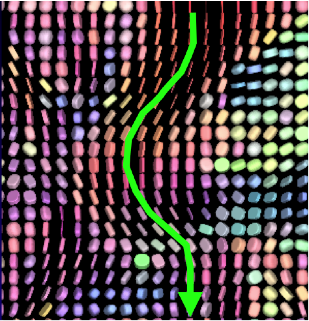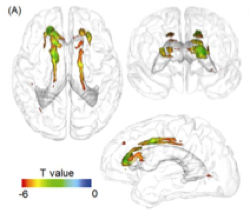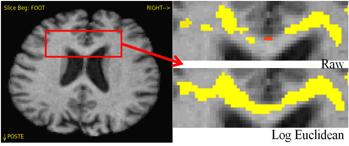
Associate Professor and Director of Biomedical Imaging

Diffusion MRI is a technique that provides indirect measures of the integrity of the axon tracts that carry information throughout the brain. At every location in the brain, diffusion MRI tells you whether or not water diffusion there preferentially takes place along particular directions. Here is a rendering of part of a diffusion MRI scan of a brain—the “pill” shapes are more thin and pointed if the water diffusion prefers one particular direction locally, and more lumpy and round if water is diffusing in many different directions there. Axon tracts tend to follow directions of highly preferential water diffusion, as shown by the green line below. Many such axon tract lines, traced throughout the brain, are shown in colors at upper left.

I have worked with members of my own lab and members of Charlie DeCarli’s lab to use these measurements to describe how these axon tracts break down during old age and how their integrity relates to mental abilities. We have found that diffusion MRI measures are sensitive predictors of subtle cognitive deficits in elderly individuals, and they are so sensitive to vascular risk factors that they may be something like the “canary in the brain’s coalmine,” i.e. the earliest indicator that the adult brain has deviated from a healthy state. The most striking finding is from the third generation of the Framingham Heart Study: these individuals showed diffusion MRI deficits associated with high blood pressure even though the average age of this group was only about 40 years old.
This figure shows, in color, the locations in the brain where greater blood pressure was associated with poorer brain health as measured by diffusion MRI.

These findings suggest that diffusion MRI may play an important role in detecting the earliest and most subtle brain changes associated with physical health and late-life cognitive decline.
The problem with diffusion MRI is that it is mathematically complex: each “image” provides not just a single number at every location, but a directional thing. How exactly to process diffusion MRI data in a way that precludes strange, spurious study results is still up for debate. I have begun collaborations with statisticians, especially Jie Peng, Debashis Paul, and Luda Sakhanenko, to better understand the theoretical properties of diffusion MRI processing operations so that we can better understand what the data is and isn’t telling us as we manipulate it in various ways. Here is an example from undergraduate Varsha Viswanath’s work suggesting that which locations in the brain have axon tract health declining with age (yellow pixels on the right) depends on whether you try to remove noise from the diffusion MRI data (bottom right) or don’t (upper right).

Publications:
Pauline Maillard, Sudha Seshadri, Alexa Beiser, Jayandra Himali, Rhoda Au, Evan Fletcher, Owen Carmichael, Philip A Wolf, Charles DeCarli. Effects of systolic blood pressure on white-matter integrity in young adults in the Framingham Heart Study: a cross-sectional study. The Lancet Neurology, Volume 11, Issue 12, December 2012, Pages 1039-1047. DOI
Samuel Neal Lockhart, Adriane B. V. Mayda, Alexandra E. Roach, Evan Fletcher,Owen Carmichael, Pauline Maillard, Christopher G. Schwarz, Andrew P. Yonelinas, Charan Ranganath, Charles DeCarli. Episodic memory function is associated with multiple measures of white matter integrity in cognitive aging. Frontiers in Human Neuroscience, 6(56), 2012. DOI
Jing He, Victoria S. S. Wong, Evan Fletcher, Pauline Maillard, Dong Young Lee, Ana-Maria Iosif, Baljeet Singh, Oliver Martinez, Alexandra E. Roach, Samuel N. Lockhart, Laurel Beckett, Dan Mungas, Sarah Tomaszewski Farias, Owen Carmichael, Charles DeCarli. The contributions of MRI-based measures of gray matter, white matter hyperintensity and white matter integrity to late-life cognition. In Press, American Journal of Neuroradiology, 2011. DOI
Dong Young Lee, Evan Fletcher, Oliver Martinez, Natalia Zozulya, Jane Kim, Jeannie Tran, Michael Buonocore, Owen Carmichael, Charles DeCarli.Vascular and degenerative processes differentially affect regional interhemispheric connections in normal aging, mild cognitive impairment, and Alzheimer’s disease. Stroke, 2010 Aug;41(8):1791-7. DOI
Varsha Viswanath, Evan Fletcher, Baljeet Singh, Noel Smith, Debashis Paul, Peng Jie, Jun Chen, Owen T. Carmichael. Impact of DTI Smoothing on the Study of Brain Aging. Proceedings of the International Conference of the IEEE Engineering in Medicine and Biology Society (EMBC 2012). DOI